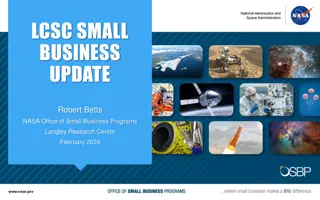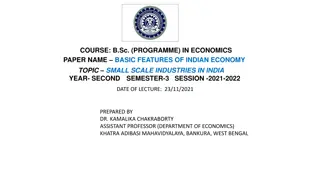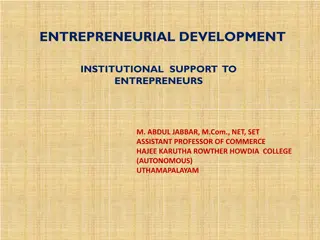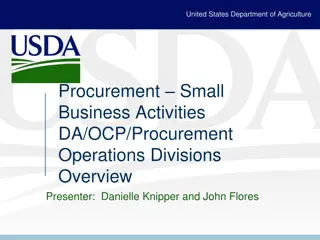Overview of Small Scale Industries and Business Ideas for Women
Small Scale Industries (SSI) encompass a range of industrial undertakings with limited investment in plant and machinery. The objectives of SSI include employment generation, regional development, resource mobilization, and technology adoption. Ancillary Industries, Tiny Industries, and Cottage Industries play integral roles in the economy. Additionally, the content discusses business ideas tailored for women entrepreneurs.
Download Presentation

Please find below an Image/Link to download the presentation.
The content on the website is provided AS IS for your information and personal use only. It may not be sold, licensed, or shared on other websites without obtaining consent from the author. Download presentation by click this link. If you encounter any issues during the download, it is possible that the publisher has removed the file from their server.
E N D
Presentation Transcript
* Unit 2: SMALL SCALE INDUSTRIES MAMATHA.D BBA DEPARTMENT BMS COLLEGE FOR WOMEN
Small Scale Industries - Tiny Industries - Ancillary Industries - Cottage Industries Definition Meaning -Product Range - Capital Investment - Ownership Patterns - Importance and Role played by SSI in the development of the Indian Economy - Problems faced by SSI s and the steps taken to solve the problems - Policies Governing SSI s
* Small Scale Industries: These are the industrial undertakings having fixed investment in plant and machinery, whether held on ownership basis or lease basis or hire purchase basis not exceeding Rs. 1 crore. The Government has raised the ceiling of investment in Plant and Machinery for SSI sector, Small Scale Industries units are those with investments in Plant and Machinery upto Rs. 1 crore other than a few specified industries such as Pharmaceuticals, textiles and sports goods where are cutoff investment limit stands at Rs. 5 crore. https://www.youtube.com/watch?v=fXiqk05sr5U
* Objectives of Small Scale Industries: 1. To create more employment opportunities with less investment. 2. To remove economic backwardness of rural and less developed regions of the economy. 3. To reduce regional imbalances. 4. To mobilise and ensure optimum utilisation of unexploited resources of the country. 5. To improve standard of living of people. 6. To ensure equitable distribution of income and wealth. 7. To solve unemployment problem. 8. To attain self-reliance. 9. To adopt latest technology aimed at producing better quality.
* BUSINESS IDEAS FOR WOMEN https://www.youtube.com/watch?v=5CO2_LI1TbY Tiny Industries: These refer to undertakings having fixed investment in plant and machinery not exceeding Rs. 25 lakhs. These also include undertakings providing services such as laundry, Xeroxing, repairs and maintenance of customer equipment and machinery, hatching and poultry etc. Located in towns with population less than 50,000. Ancillary Industries: These are industrial undertakings having fixed investment in plant and machinery not exceeding Rs. 1 crore engaged in or proposed to engage in, (a) The manufacture of parts, components, sub-assemblies, tooling or intermediaries, or (b) The rendering of services supplying 30 percent of their production or services as the case may be, to other units for production of other articles.
* Cottage Industries: Definition An industry where the creation of products and services is home -based, rather than factory - based. While products and services created by cottage industry are often unique and distinctive given the fact that they are usually not mass - produced, producers in this Sector often face numerous disadvantages when trying to compete with much larger factory- based companies an industry whose labour force consists of family units or individuals working at home with their own equipment a small and often informally organized industry a limited but enthusiastically pursued activity or subject Examples of cottage industry - Weaving, Pottery, and other cottage industries. Export-Oriented Unit (EOU): An industrial undertaking in which the investment in fixed assets in plant and machinery, whether held on ownership terms, or on lease or by hire purchase, does not exceed Rs. 1 crore and has an obligation to export 30% of production.
* Product Range: The small-scale sector has acquired a prominent place in the socio-economic development of the country as it not only acts as a nursery for the development of entrepreneurial talent, but also producers a wide range of 7,500 products. Important products which are very commonly produced by different small-scale industries are as follows: TYPES OF INDUSTRIES: PART1 https://www.youtube.com/watch?v=daeuF3J2IZo https://www.youtube.com/watch?v=5KTClB4HdzQ A] Agro-based Industries: 1. Processing of agro-products like rice, pulses, spices cane juice and fruits juices, making jams and jellies, jaggery from cane juice and wheat and maize products. 2. Honey making, making pickles and papads, processing of fruits and vegetables. 3. Floriculture and selling flowers, garlands and bouquets at local and export markets. 4. Manufacture of coir mats, leaf cup making, cashew processing, tobacco processing, tea leaves processing etc.
* B] Engineering Industries: 1. Tiny sector consists of carpentry, blank smithy, manufacture of utensils, servicing of household equipment, electrical and electronic gadgets. 2. Manufacture of office stationary like pins, staples, files, furniture and decorative items. 3. Manufacture of aluminium and its alloys, copper and its alloys components for various usage in industries as well as for decorative purposes in buildings. 4. Manufacture of iron and steel components required for bigger industries. 5. Production of components required for electronics and computer related goods. 6. Manufacture of steel fabricated items like gates, windows, doors and components for various requirements of industries and buildings. 7. Manufacture of components for various vehicles for bicycle to cars, trucks and railways. 8. Manufacturing equipment and components for entertainment business.
* C] Forest based Products: Manufacturing various cane furniture and facilities from bamboo and its cuttings. Manufacturing handmade paper, processing gum collected from trees and processing jute products. Making of brooms of different varieties, agarbattis and fire woods cuttings. Manufacture of various types of plates and cups from leaves of specific trees. D] Chemical based Industries: Processing of various types of soaps and detergents. Curing and tanning of animal skins. Producing various leather goods from processed animal skins. Production of various components and goods from rubber, rexin and PVC. Manufacture of various types of oils and lubricants. Manufacturing of items like hair oils, shampoo, wax-candle, camphor and ceiling waxes.
* E] Textile Based Industries: Garment industries for both domestic and export markets. Hosiery industry, embroidery, tool making. Manufacturing of surgical bandages, various types of handlooms cloths and safety items. F] Mineral Based Industries: Pottery, slate, pencil making, plaster of Paris items. Brick making, lime stone crushing and jelly stones crushing for construction work. Manufacture of red oxide, distemper and varnishes. G] Service Sector: Manual services like plumbing, hair styling, beauty parlours, laundry, electrical repairs and appliances repairs. Repairing and service of equipment like pumps, vehicles, diesel engines etc. Repair and service for items like agriculture equipment, batteries, vulcanising. Repair and maintenance of buildings, offices and gardens.
* Capital Investment: Proper financing of business is essential for success in small and large organisation. This can be achieved through financial planning. Financial Planning: The decisions taken by the entrepreneur well in advance regarding the future financial aspects of his/her enterprise is called financial planning . In a financial plan, the entrepreneur should clearly answer the following three questions: How much money is needed? Where from the money will come? When does the money need to be available? These three questions are concerned respectively with the estimation of financial needs, sources of finance, and the investment of finance/capital.
* Sources of Finance: Internal Sources ---A) Owner s Capital External Sources---A) Debentures. B) Term-loans from financial institutions. C) Credit facilities from commercial banks. D) Deposits or borrowings from relatives, friends and others. E) Hire-purchase or leasing facility from the National Small Industries Corporation (NSIC) and State Small Industries Corporations (SSICs),etc. F) Trade Credit. G) Seed/Margin money, subsidies from the government and the financial institutions. B) Deposits and loans C) Loans raised by the entrepreneurs D) Retention of profits or Reinvestment
* Capital Structure: Capital structure means the permanent financing of the enterprise represented primarily by long-term sources of funds, i.e debt and equity. Optimum Capital Structure: 1) An optimum capital structure bears the following important features: 2) The capital structure should involve the minimum cost and the maximum yields. 3) The adopted capital structure should be flexible enough to fulfil the future requirements of the capital as and when needed. 4) The use of the debts should be within the repaying capacity of the enterprise. In fact, failure to organize this important aspect/fact is the common cause of financial strain among the small scale enterprise. 5) The capital structure should ensure the proper control over the affairs of the enterprise.
* Ownership Patterns: 1. Sole Proprietorship 2. Partnership firm 3. Joint Stock company 1. Private limited company 2.Public limited company 4. Co-operative society 5. Public Sector enterprise 1.State Government owned 2. Central Government owned
* Role played by SSI in the development of the Indian Economy 1. Employment generation 2. Mobilisation of resources and entrepreneurial skill 3. Equitable distribution of income 4. Regional dispersal of industries 5. Provides opportunities for development of technology 6. Indigenisation 7. Promotes exports 8. Supports the growth of large industries 9. Better industrial relations 10.Labour-intensive
* Problems faced by SSIs: 1. Poor capacity utilization 2. Incompetent management 3. Inadequate Finance 4. Raw material shortages 5. Lack of marketing support 6. Problem of working capital 7. Problems in Export 8. Lack of technology up-gradation 9. Multiplicity of labour laws 10.Inability to meet environmental standards 11.Delayed payments 12.Poor industrial relations 13.Strain on government finances 14.Concentration of industrial units 15.Inadequate dispersal 16.Widespread sickness 17.Lack of awareness 18.Government interference
* The steps taken to solve the problems: 1. Financial Assistance 2. Marketing Assistance 3. Technical Assistance 4. Infrastructural Facilities 5. Industrial Estates 6. Allocation of raw materials and other equipment 7. Reservation of item https://www.youtube.com/watch?v=GvLR8Txwtko
* Policies Governing SSIs New Industrial Policy 1991: A) Industrial licensing 1. It emphasised on the growth of small-scale enterprises with a view to contribute to national production, exports and employment. 2. It increased the limit of investment in plant and machinery for small- scale industries to Rs. 60 lakhs, for ancillary units to Rs. 75 lakhs, for export-oriented units to Rs. 75 lakhs, and for tiny sector to Rs. 5 lakhs 3. The scope for National Equity Fund Scheme was widened to cover projects up to Rs. 10 lakhs for their equity support. The equity support was to be extended up to 15%. 4. Single window loan scheme was extended to cover projects up to Rs. 20 lakhs with working capital margin up to Rs. 10 lakhs. B) Foreign Investment C) Foreign technology policy D) Public sector policy, and MRTP Act
5) Factoring services were initiated through small Industries Development Bank of India (SIDBI) in order to solve the problem of delayed payment to small sector by the large units. 6. To improve productivity and competitive strength of the small- scale sector, a Technology Development Cell (TDC) would be set up in the Small Industries Developmental Organisation (SIDO). This cell would co-ordinate technical activities of the existing units with other industrial research centres to promote technical efficiency of these units. 7. Khadi and village industries would be promoted through expansion of activities of khadi and village industries commission and the State Khadi and Village Industries Boards. 8. A scheme of integrated infrastructural development would be developed to promote location of industries in rural and backward areas. This was to promote regional balanced development of the economy.
Fiscal Support Credit Support Infrastructural Support Technological Support and Quality Improvement Marketing Support ------------- THANK YOU























